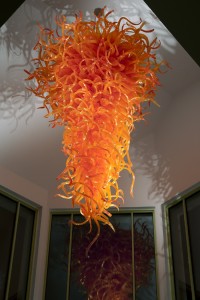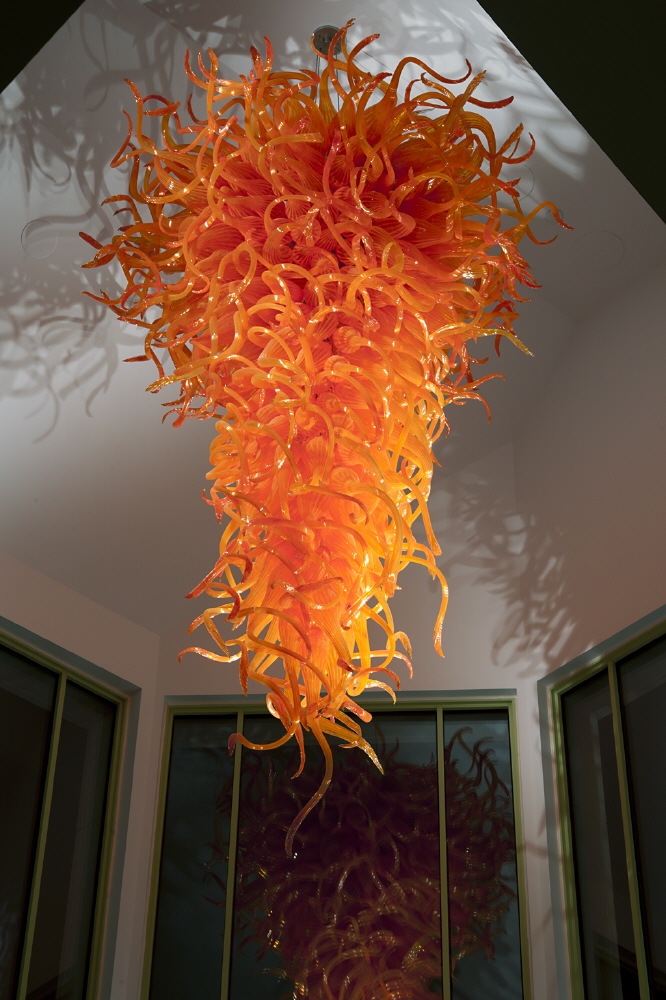Every other week we’ll be posting information about pieces in the Beach Museum’s permanent collection from …to build up a rich collection.. Selected works from The Marianna Kistler Beach Museum of Art.
All pieces in this series are on display now at the museum. We hope you will join in the discussion and enjoy learning in-depth about the heart of the museum, our permanent collection. Beginning with one of the pieces that welcome you to the Beach Museum, Chandelier by Dale Chihuly. What does this piece make you wonder?

Dale Chihuly, born in 1941 in Tacoma, Washington, is considered on of the world’s foremost artists working in glass. Chihuly has become famous for liberating glassblowing from the confines of craft and placing it firmly in the sphere of fine art.1 In 1992 he made his first chandelier, which was created in conjunction with an exhibition at the Seattle Art Museum. At Seattle Chihuly become discontent with a vacant space within the exhibition. His solution was to create a hanging sculpture composed of a multitude of glass spheres. The main appeal of this first piece was not primarily derived from the simple shape of the individual components but from the grouping of these elements into a new structure.2The sheer size and volume of this first chandelier is only half of its attraction. The uniform and vibrant color makes the piece even more dramatic. This first chandelier led to a series of hanging pieces that are now considered among Chihuly’s signature forms.
In 1996 Dale Chihuly met with Arthur Andersson, architect of the Beach Museum of Art, to discuss the best placement of a chandelier within the building. On this trip to Kansas, Chihuly also toured the nearby countryside and viewed photographs of prairie burning, which he found particularly inspirational. Chandelier, commissioned for the Beach Museum of Art in 1996, is a continuation of Chihuly’s basic chandelier form. It weighs approximately 1,600 pounds and is composed of over 300 hand-blown glass pieces, all of which are a brilliant orange. The pieces are attached by wire to an armature composed of a steel basked with a descending steel chain. Each piece begins with a knob-like head, swells to a bulbous thorax, and concludes with a serpentine tail. Though at first glance the individual pieces appear identical there are variations: some pieces are longer, others are shorter, all have tail ranging from nearly straight to curvy.
Chandelier is related to other Chihuly hanging sculptures with its combination of related shapes, the massing of color, and its prodigious size. However, there are also site-specific elements that make this very much a Kansas piece. The subtle tail ends of each piece of glass suggest heads of wheat, a reference to the state’s great crop. The fiery orange color and flame-like shape of the individual elements also evoke the Kansas practice of prairie burning that Chihuly found so visually compelling. This burning, which occurs yearly in the spring, consumes both dead grass and unwanted small trees, thereby facilitating new growth. This rebirth through fire can be linked to glass production itself. Working in glass, Chihuly and his team of artists create new beauty through the catalyst of flame. The Beach Museum’s Chandelier resembles and inverted pyramid of flames suggesting both the creation of glassblowing and the regeneration initiated by prairie burning. BJ

KSU, Beach Museum of Art, acquisition made possible with fund provided by Bebe & R. Crosby Kemper and Joann & Jack Goldstein
Brent Jackson, “Dale Chihuly” in Bill North, Brent Jackson, and Kate Meyer, …to Build up a Rich Collection.. Selected Works from the Marianna Kistler Beach Museum of Art. (Manhattan: Marianna Kistler Beach Museum of Art, Kansas State University, 2003), 80.
1Henry Geldzahler, “Dale Chihuly as of 1993,” in Walter Darby Bannard and Henry Geldzahler, Chihuly: Form From Fire (Daytona Beach, Florida: Museum of Fine Arts and Sciences Inc., in association with University of Washington Pres, 1993), 13.
2Donald B. Kuspit, Chihuly, rev. ed. (New York: Harry N. Abrams, Inc., 1998), 226.